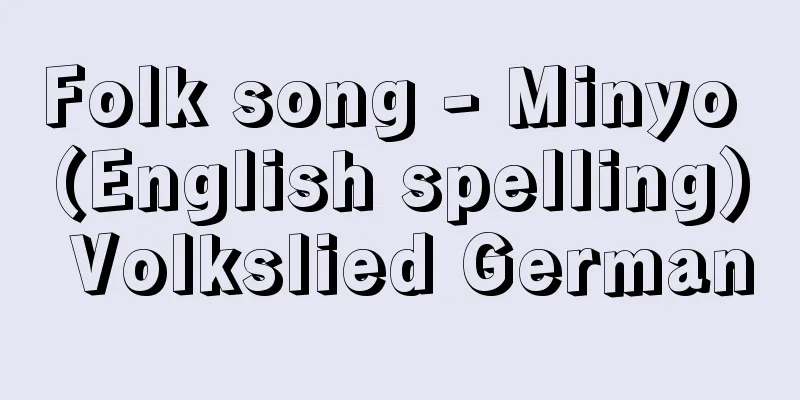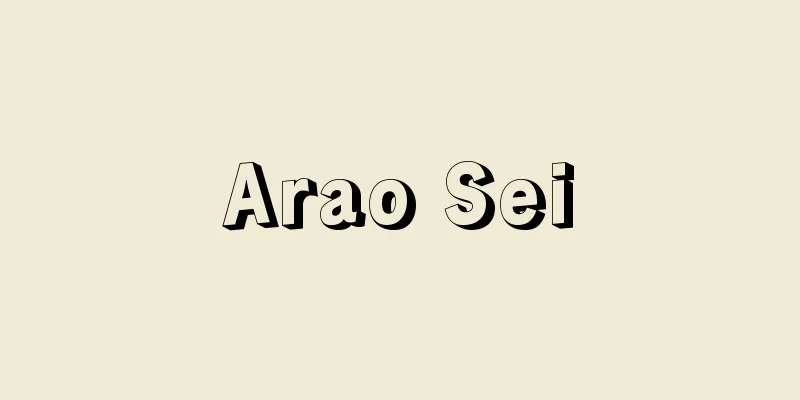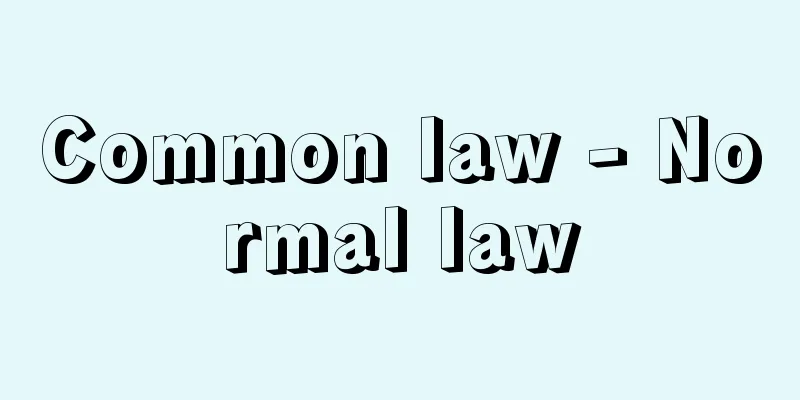Folk song - Minyo (English spelling) Volkslied German

|
Generally speaking, they can be understood as "songs that were born in the daily lives of the people and have been passed down through the generations," but the concept and definition vary significantly depending on the era and ideological background. It is said that the Japanese word "minyo" began to be used in its modern sense in the 1890s, during the mid-Meiji period, when Mori Ogai, Ueda Bin and others began to use it as a translation of the German word Volkslied (or its English translation, folk song). However, this German word itself was a compound word (Volks = people, Lied = song) proposed by the German thinker Herder in 1773. Therefore, reflecting the circumstances of its establishment, it can be pointed out that the concept of "minyo" has historical and spatial constraints. Historical constraints mean that the concept of folk song arose from the ideological background of German Romanticism. For German Romantics, folk song was a kind of mystical and natural product of the folk spirit. Later, this idea was criticized, and even the extreme opinion that the concept of folk song is a poetic fiction, merely a dream of Romantic writers and the researchers who followed them, emerged, which could be called the folk song fiction theory. Regardless of the fiction theory, even today the concept of folk song still has some romantic coloring, but when thinking about folk song, it is necessary to keep these historical constraints in mind. The spatial constraints come from the fact that the word Volk originally referred to the people of the lower classes. In other words, the term folk song includes the premise that it refers to songs performed by the lower classes in a stratified society (it goes without saying that European feudal society is one model). Therefore, the concept of folk song is difficult to establish in societies where stratification did not exist or was relatively small (such as Melanesia in Oceania), and it can be said that there are naturally spatial constraints on the application of the concept of folk song. Taking into full account the above-mentioned limitations of the concept of folk song, we will consider the definition and characteristics of folk song. [Ryuichi Tai] DefinitionThere have been many discussions about the definition of folk music in the past, but here we will look at the definition adopted at the San Paulo meeting of the International Folk Music Council (IFMC) in 1954 (renamed the International Council for Traditional Music (ICTM) in 1981). This definition was elaborated as a compilation of previous definitions of folk music, and is believed to apply to most folk songs as well. In the following, I will introduce "folk music" by replacing "folk song" with "folk music. First, folk song is said to be the product of a musical tradition that grew within a community and developed through a process of oral transmission. The factors that shape this tradition include continuity that connects the present with the past, transformations that arise from the creative impulse of individuals or groups, and community choices that determine the musical forms or diverse forms that have been preserved until now. From the above definition, five characteristics of folk songs can be extracted: (1) community, (2) oral tradition, (3) continuity, (4) transformation, and (5) selection. I will now explain them in detail. The examples are mainly from Europe, but this is simply because in the history of folk song research, there is a relatively large amount of material available thanks to the efforts of Cecil Sharp in England, Bartók and Kodály in Hungary, and Constantin Brailloj in Romania. [Ryuichi Tai] Features(1) Community Folk songs are sung by members of a community, who share in work, rituals, faith, and entertainment. Folk songs are therefore closely related to these things. There are a wide variety of work songs related to daily work, such as songs about cutting grass, spinning, milking, and milling. These songs do not simply serve the function of increasing work efficiency, but are sometimes said to have a kind of magical power, such as promoting crop growth, as in the case of Bulgarian plowing songs. As for songs related to rituals, the main focus is on songs related to life rites such as birth, coming of age, marriage, and death. Wedding songs in particular are found throughout Europe, and the songs to be sung for each wedding scene are often strictly determined. The lyrics are also highly symbolic. Furthermore, lamentations for the dead are found throughout the country, and in Romania, they are sung by professional mourners. Examples of songs related to faith include rain-making songs common around the Balkan Peninsula, and songs for processions to sacred places in Spain and Italy. It is said that songs sung by shepherds in Northern Europe and Switzerland to herd livestock originally had a strong magical flavor to protect people from disaster. Songs related to annual events such as spring and autumn festivals have also been handed down in various regions. There are also countless other songs, including those that accompany dances and those connected to performing arts. In this way, folk songs are closely linked to communities and the daily life within them, and they would not exist apart from the community. (2) Oral Transmission Folk songs are mainly transmitted orally. However, not all folk songs are transmitted orally. In Europe, folk songs were circulated in printed form from the early Middle Ages, and in Japan, many books collecting the lyrics of folk songs were published during the Middle Ages and early modern times. Despite this situation, oral transmission is extremely important in folk songs. This is because oral transmission is not just a way to transmit folk songs, but also includes the process of recreating folk songs. Traditionally, oral transmission has been said to be vague and non-normative. Although it is true that "forgetting" is an unavoidable aspect of the oral transmission form, it is problematic to emphasize this too much. Rather, we should emphasize the fact that because it is an oral transmission form, people have been able to put their own ideas into the folk songs they have inherited, and that this has allowed folk songs to be recreated. A folk song researcher visited Scotland for the first time in several decades and asked the singer from his previous research to sing the same song again. When he compared the two versions, the two versions were quite different. At first, the folk song researcher thought that this was because the singer had forgotten the original song, but after further investigation, he found that the song had changed as the singer's life experiences deepened. The song will probably be passed down to his children, who will likely pass it on to the next generation in their own way. As these episodes show, oral tradition is not just one way of passing down folk songs, but it is also a process of constant rebirth and re-creation. It should be noted that oral tradition is often accompanied by gestures and physical movements. (3) Continuity Folk songs need a certain degree of continuity over time to maintain their traditional character. This may seem to contradict what is stated in the sections on oral tradition and transformation. However, while it is impossible to imagine a tradition that does not change at all, it is also impossible to imagine a tradition that changes without a trace. Folk songs usually have a certain degree of spatial and temporal continuity, which is a criterion for distinguishing them from passing popular songs. Also, folk songs can sometimes show astonishing continuity, and Cecil Sharp has reported a case in which a British ballad from hundreds of years ago is still being sung today in the Appalachian Mountains of North America, thousands of kilometers away. (4) Transformation The issue here is the process by which folk songs were created. Traditionally, there have been two theories about the process by which folk songs were created: the "creation theory" (Joseph Pommer et al.), which claims that folk songs are created by the masses and then sung and transformed; and the "acceptance theory" (Hans Naumann et al.), which claims that folk songs are simply compositions by the upper classes of society that are passed on to the lower classes and then sung and distorted. However, when the actual process of creation is examined in detail, both cases exist, and it is impossible to limit it to one or the other. Rather, what we must pay attention to here is the fact that, in either case, folk songs are always transformed by the people. Another issue that has long been debated is whether the creator (composer) of a folk song is an "individual" or a "group." The "collective creation" that has been discussed in the past is the exception except in special cases. The creator (composer) of a folk song is usually an individual, but he or she has a kind of anonymity. In other words, in some regions, the name of the creator (composer) may be passed down along with the folk song, but usually, a specific creator (composer) is not an issue. This seems to be related to the fact that the creation (composition) of a folk song is not completed by an individual's composition, as in Western classical music, but is constantly being transformed and recreated by other people and groups. In any case, it cannot be overemphasized how much the transformation and subsequent recreation of folk songs make them lively. (5) Selection Folk songs are selected and accepted by the community, whether they have been imported from elsewhere or created by a particular individual. And as mentioned above, even those that are accepted are always transformed by the members of the community. Conversely, even if it is a popular urban song or a military song, if it has been selected and accepted by the community, it can also be called a folk song. In this sense, the community's selection serves as a think tank that directs the birth and development of folk songs. From the above, it can be said that the essential characteristic of folk songs lies in their adaptation and re-creation within the community. [Ryuichi Tai] Contemporary folk songsWith the rapid changes in society in recent years, folk songs that have been nurtured in the daily lives of traditional communities are gradually being lost. At the same time, we are seeing more and more songs arranged for tourism, songs composed by professional composers, and songs linked to the mass media. It is easy to criticize these kinds of songs as "second folk songs" or "fake folk songs." However, even if they are for tourism, if they are accepted and given meaning by the people of the "community," they are genuine "folk songs" and should be treated as orthodox. As long as this series of functions within the community exists, folk songs are unlikely to disappear. [Ryuichi Tai] "Folk Song Research Readings" edited by Akiyama Ryuei (1983, Ongaku No Tomosha)" ▽ "German Folk Songs" by Zuppan, translated by Sakanishi Hachiro (1973, Iwasaki Bijutsusha)" ▽ "Irish Folk Music and Dance" by Branack, translated by Takeshita Eiji (1985, Zen-On Music Publishers)" ▽ "W. Danckert Das europaisch Volkslied (1970, Bouvier)" ▽ "P. Kennedy (ed.) Folksongs of Britain & Ireland (1975, Casseu)" [Reference] |Source: Shogakukan Encyclopedia Nipponica About Encyclopedia Nipponica Information | Legend |
|
一般的には「民衆の生活のなかで生まれ、うたい継がれてきた歌」と解することができるが、その概念、定義には時代および思想的背景による相違が顕著である。 日本語の「民謡」ということばが今日でいう意味で使われ始めたのは、明治中期の1890年代に森鴎外(おうがい)、上田敏(びん)らがドイツ語のVolkslied(あるいはその英訳のfolk song)の訳語として使用するようになってからだといわれている。しかしこのドイツ語自体も、1773年にドイツの思想家ヘルダーによって提唱された合成語(Volks=民衆の、Lied=歌)であった。したがってこうした成立の事情を反映して、「民謡」という概念は歴史的・空間的に制約をもっているということが指摘できる。 歴史的制約とは、民謡という概念がドイツ・ロマン派の思想的背景から生じてきたことを意味する。ドイツ・ロマン派にとって民謡とは、民衆精神の神秘的で自然的な所産の一種であった。のちにこうした考えは批判され、民謡という概念は詩的虚構であって、ロマン派の文学者や彼らに続いた研究者たちの夢みたものにすぎないという、民謡虚構論ともいうべき極端な意見も出るに至った。虚構論はともかくとして、今日においても民謡という概念は、多少なりともこうしたロマン的な色彩を帯びているとはいえ、民謡について考える際には、こうした歴史的制約に留意する必要がある。 空間的制約とは、Volkということばが元来、国民のなかの基層の人々を指し示していることに由来する。すなわち、民謡ということばには、階層化された社会(ヨーロッパ封建制社会が一つのモデルとして措定されていることはいうまでもない)における基層社会の人々が担う歌という意味合いがその前提として含まれている。したがって、階層化が生じなかったり、比較的少なかった社会(たとえばオセアニアのメラネシア社会など)においては民謡の概念は成立しにくいのであり、民謡の概念の適用にはおのずと空間的な制約があるといえる。 民謡という概念には以上のような制約があることを十分に踏まえたうえで、民謡の定義、特色などについて考察する。 [田井竜一] 定義従来民謡の定義に関しては、さまざまな議論がなされてきたが、ここでは、1954年に国際民俗音楽協会International Folk Music Council=IFMC(1981年に国際伝統音楽協会International Council for Traditional Music=ICTMと改称)のサン・パウロ会議で採択された民俗音楽の定義を取り上げる。これはいままでの民俗音楽の定義を集大成する形で練り上げられたもので、この定義はほぼ民謡にも当てはまると思われる。 以下、「民俗音楽」を「民謡」に読み替えて紹介すると、まず民謡は共同体のなかにおいて育ち、口伝の過程を通して発展してきた音楽伝統の所産であるとされる。そしてこの伝統を形成する諸要因として、現在と過去とを結び付ける継続性、個人あるいは集団の創造的衝動から生ずる変形、いままで残されてきた音楽の形あるいは多様な形の決め手となる共同体の選択があげられている。 以上の定義から、(1)共同体、(2)口伝、(3)継続性、(4)変形、(5)選択という民謡における五つの特色を抽出することができる。次にそれらについて詳細に述べる。具体例はヨーロッパのものが中心になるが、これは単に民謡研究史上、イギリスのセシル・シャープ、ハンガリーのバルトークとコダーイ、ルーマニアのコンスタンティン・ブライロユらの活躍によって資料が比較的そろっているという理由によるにすぎない。 [田井竜一] 特色(1)共同体 民謡の担い手は共同体の構成員であり、彼らは労働・儀礼・信仰・娯楽をつねにともにする人々であった。したがって民謡も、そうした事柄と密接に関連している。日々の労働に結び付いた仕事歌には、草刈り歌や紡ぎ歌、乳搾りの歌、粉挽(ひ)き歌など多彩なものがある。これらの歌は、単に仕事の能率を高める機能を果たしているだけではなく、たとえばブルガリアの耕作歌のように、作物の成長を促進させるといった一種の呪術(じゅじゅつ)的な力ももっているとされる場合もある。儀礼に関したものでは、誕生・成年・結婚・死といった人生儀礼にまつわる歌がその中心になる。とくに婚礼の歌はヨーロッパ各地にみられ、しかも婚礼の各場面に即してうたわれる歌が厳密に決められていることが多い。またその歌詞はきわめて象徴性に富んでいる。さらに死者への哀歌も各地にみられ、ルーマニアなどでは職業的泣き女によってうたわれる。信仰に関連したものでは、バルカン半島周辺に多くみられる雨乞(あまご)い歌や、スペイン、イタリアなどの聖地行列の歌などがあげられる。なお北欧やスイスの羊飼いがうたう家畜集めの歌も、本来は災いから身を守るための呪術的な色彩が強かったといわれている。また春・秋の祭りなどの年中行事にまつわる歌も各地に伝承されている。そのほか、踊りに伴う歌や芸能と結び付いた歌など、枚挙にいとまがない。このように民謡は共同体、およびそこでの日々の暮らしと密接に結び付いており、共同体を離れては民謡は成立しえないのである。 (2)口伝 民謡の伝承はおもに口頭による。しかし、すべての民謡が口伝・口承で伝承されているわけではない。ヨーロッパにおいても中世の早い時期から、印刷物の形で民謡が流布していたし、日本においても中世・近世にかけて多数の民謡の詞章を集めた書物が出版された。こうした状況があるにもかかわらず、口伝は民謡においてきわめて重要な意味をもっている。それは、口伝が単に民謡を伝承する方式であるだけではなく、民謡を再創造する過程をうちに含んでいることに由来する。従来口伝による伝承はあやふやで、規範的でないといわれてきた。確かに「失念」は口伝という伝承形式の避けられない点ではあるが、あまりにそれを強調してしまうのは問題である。むしろ口伝という伝承形式であるがゆえに、人々は自分が受け継いできた民謡に自分なりのくふうを凝らすことができ、それによって民謡が再創造されてきた点を重視すべきであろう。 ある民謡研究者が数十年ぶりにスコットランドを訪ねて、前回の調査でうたってもらった人に同じ歌をもう一度うたってもらい、前のものと比べてみたところ、その二つはかなり違ったものであった。最初その民謡研究者は、本来の歌を失念してしまったせいかと考えたのだが、詳しく検討した結果、そうではなくて、その歌い手の人生経験の深まりによって民謡もその姿を変えていったことがわかったのである。おそらくその民謡は彼の子供たちに伝えられるであろうが、子供たちも彼らなりのくふうをして次の世代に伝えていくことであろう。こうしたエピソードが物語っているように、口伝は民謡が伝承されていく方法の一つであるにとどまらず、それがつねに生まれ変わり、再創造される過程でもあるのである。なお、口伝に際しては、身ぶりや身体動作を伴って伝承されることも多いことを指摘しておきたい。 (3)継続性 民謡がその伝承性を保つためには、それなりの時間的継続性が必要である。このことは口伝や変形で述べる事柄と矛盾するように思われるかもしれない。しかし、まったく変化の生じない伝承も考えられない一方で、跡かたもなく変わってしまうという伝承も考えられない。民謡は、ある一定の範囲での空間・時間的継続性をもっているのが普通で、そのことが民謡を一時的な流行歌と区別する基準になる。また、民謡はときとして驚異的な継続性をみせることがあり、何百年も前のイギリスのバラッドが、何千キロメートルも離れた北米のアパラチア山脈で現在もうたい継がれているという事例を、セシル・シャープが報告している。 (4)変形 ここでは民謡の成立過程が問題になる。従来、民謡の成立過程については、民謡は民衆によってつくりだされ、うたい変えられていくと主張する「創造説」(ヨーゼフ・ポンマーら)と、民謡は社会の上層の人々が作曲したものが下層に流れ、うたい崩されていくものにすぎないという「受容説」(ハンス・ナウマンら)の二つの説があり、さまざまな議論がなされてきた。しかし実際の成立過程を詳細に検討すると、両方のケースが存在し、どちらか一方に限定することは不可能である。むしろここで注目しなければならないのは、どちらの場合にせよ、民謡がつねに人々によって変形されていくという事実である。 また古くから議論されてきたもう一つの問題に、民謡の創始者(作曲者)は「個人」か「集団」かというのがある。従来とかく議論された「集団創作」は、特殊な場合を除いては例外的である。民謡の創始者(作曲者)は通常は個人であるが、彼は一種の匿名性を帯びている。つまり、地域によっては創始者(作曲者)の名前がその民謡とともに伝承される場合もあるが、通常は特定の創始者(作曲者)が問題にされないことのほうが多い。これは民謡における創作(作曲)が、西洋古典音楽などでいわれるような、個人の作曲によって完了するのではなく、他の人々や集団によってつねに変形され、再創造され続けることと関係があるように思われる。いずれにしても、民謡における変形およびそれによる再創造が民謡をどれだけ生き生きしたものにしているかについて、強調しすぎることはない。 (5)選択 たとえそれが他の場所から移入されたものであるにせよ、特定の個人が創作したものにせよ、民謡は共同体によって選択され、受け入れられていく。また受け入れられたものも、前述のように、つねに共同体のメンバーによって変形されていくのである。逆にいえば、たとえそれが都市の流行歌や軍歌などであっても、それが共同体に選択され、受容されたものであるならば、民謡とよぶこともできる。こうした意味で共同体の選択は、民謡の誕生と展開を方向づけるシンク・タンクとしての役割を果たしているといえるだろう。 以上みてくると、民謡の特色の本質は、共同体における改作と再創造にあるということができよう。 [田井竜一] 現代における民謡近年の社会の急激な変化に伴って、伝統的な共同体の暮らしのなかではぐくまれてきた民謡もしだいに失われつつある。そうした一方、観光用にアレンジされたものや、専門の作曲家によってつくられたもの、マスコミに結び付いたものなどが目につくようになってきている。この種のものに対して、「第二の民謡」とか「偽物の民謡」などと批判することはたやすい。しかしたとえ観光用のものであっても、それが「共同体」の人々によって受容され、意味づけられているならば、それらもれっきとした「民謡」であり、正統に扱われるべきであろう。共同体における一連の作用がある限り、民謡はけっしてなくなることはないと思われる。 [田井竜一] 『秋山龍英編『民謡研究リーディングス』(1983・音楽之友社)』▽『ズッパン著、坂西八郎訳『ドイツの民謡』(1973・岩崎美術社)』▽『ブラナック著、竹下英二訳『アイルランドの民俗音楽とダンス』(1985・全音楽譜出版社)』▽『W.DanckertDas europaisch Volkslied(1970, Bouvier)』▽『P.Kennedy (ed.)Folksongs of Britain & Ireland(1975, Casseu)』 [参照項目] |出典 小学館 日本大百科全書(ニッポニカ)日本大百科全書(ニッポニカ)について 情報 | 凡例 |
Recommend
chemotroph
…(1) Differences in energy sources The source of ...
Yahiko Shrine
A shrine in Yahiko Village, Nishikanbara County, N...
Gaudapadiya Kalika
...His disciple was Govinda, and his disciple was...
Other Arab - Azaa Arab
…Official name: United Arab EmiratesDawla al-Imār...
'Arafat (English spelling)
...Pilgrims, clad in two seamless white cloths (i...
Kihachiro Kawamoto
1925-2010 A puppet animation creator from the lat...
Basket - Curved
〘 noun 〙 A vessel used for drinking sake or water....
Electron - denshi (English spelling) electron
A type of elementary particle. Symbolized as e or...
Indian marsh deer - indonumajika
…Also known as the Indian marsh deer or marsh dee...
epitte (English spelling)
...A document in which the intended purpose is wr...
Ono no Tofu Shrine - Ono no Tofu Shrine
...There are swimming spots such as Omi Maiko (Om...
Former Ministry of India Library
... The India Office was abolished with the indep...
Woolworth Building
A skyscraper in Manhattan, New York. It is 222.2 m...
Allmende (English spelling) [Germany]
A common land, which developed typically in the Eu...
Sogakuji Temple - Sugakuji
This temple is located at the western foot of Mou...









